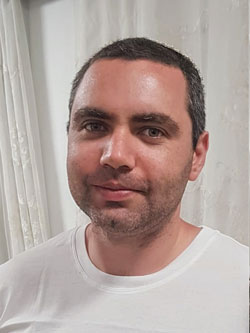More:
News & Stories
Innovative Emergency System for the elderly presented in Japan
Graduate students from HIT presented their latest innovative system at an international symposium at Tsukuba University in Japan.

Michael Gotlib

Moran Shental
Moran Shental and Michael Gotlib, both graduate students from the faculty of Industrial engineering and Technology Management, guided by Dr. Michael Winokur, presented their latest innovative system, their final Master's project, at "Life Sciences X Data Science" an international symposium at Tsukuba University in Japan.
Older people, or people with disabilities can get into a situation due to their medical condition; in which they cannot perform simple tasks and, in some cases, cannot call for help in case of a medical emergency.
There are currently human-operated systems on the market, but in an emergency, the systems are unable to analyze the situation and call for help.
However, this system is capable of identifying a medical emergency in the user's home, provide a first response autonomously, call for help, unlock the house to enable easy access for emergency teams, monitor the user's condition until help arrives and direct the emergency team to the user's location within the house.
This system is an output of system design process of emergency robotic system for the elderly or people at medical risk, the process included: survey of relevant literature and technologies, collecting and prioritizing needs, Establishment of a collection of requirements, defining system scenarios, Defining solution alternatives, choosing the solution and simulate system's operation.
The selected system was the innovative solution in this work; the system is using modern and innovative technologies to perform its main missions.
The priority of this solution was to utilize, mostly unused, space in people residence, the ceiling. Rails should be mounted across the living areas of the house and the robotic moving unit should move to the emergency position on the rails measure and transfer medical indicators and assist him if possible.
The system consists of 3 main units: detection thermal optical sensor, base unit and communication and robotic moving unit.
System main use case is:
- Detecting emergency situation
- Emergency case verification
- Call for emergency services
Moran Shental: "the inspiration for the project was based on a true incident where an elderly lady fell down at home and was unable to open the door for the rescuers. This encouraged us to think of a useful solution.
Dr. Michael Vinokur: I'm very proud of my students who thought of such creative solutions of robotic assistance that could even be applicable in the future in nursing homes".
Posted: 07/10/2021
- News & Events
International Week of Interdisciplinary Studies and Academic Collaborations in Crete
A substantial delegation of 16 students and four faculty members from HIT Holon Institute of Technology participated in week-long international activities and events at HMU-Hellenic Mediterranean University in Crete. ...


 Additional programs
Additional programs
